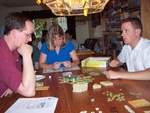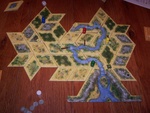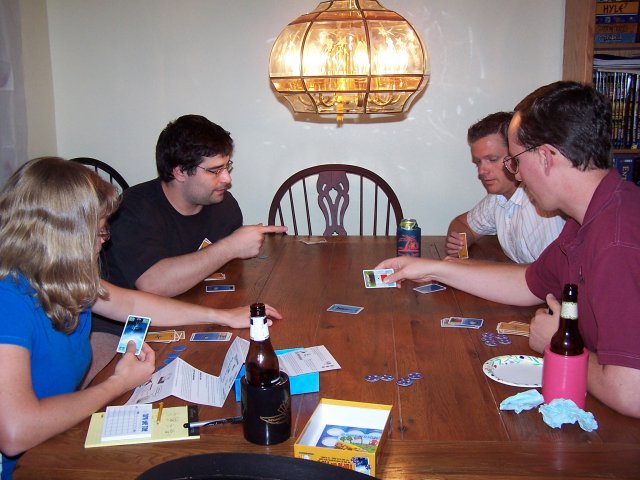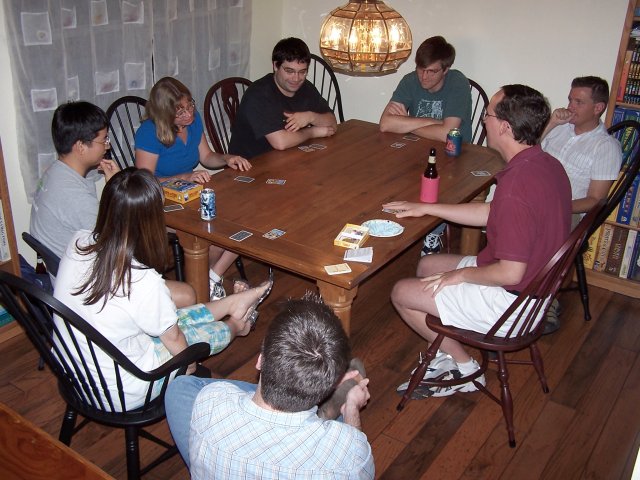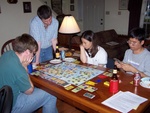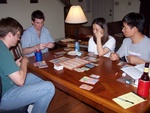
September 9, 2004Session Report for August 26, 2004by Susan Rozmiarek The unplayed games on our shelves have been slowly piling up to unacceptable levels. Tonight I was able to knock off three of them. Now we only haveÖnope, that number is still just too ridiculous to divulge. Why ever do we keep buying games and how can we stop? Or should we even care enough to try? We havenít even had to tap into the kidsí college funds to pay for them. Yet. The unplayed games on our shelves have been slowly piling up to unacceptable levels. Tonight I was able to knock off three of them. Now we only haveÖnope, that number is still just too ridiculous to divulge. Why ever do we keep buying games and how can we stop? Or should we even care enough to try? We havenít even had to tap into the kidsí college funds to pay for them. Yet.
As a break from the traditional light appetizer, Mike, Adam, Mark and I jumped right into the main course.
Lost ValleyI got all swept up in the prerelease buzz about this game. The exploration theme, buying stuff, building stuff, hunting, fishing, lots of pretty bits, the unique rhomb tiles Ė more than enough to get excited about. This was followed by the sound of my over inflated balloon of expectation bursting as a steady flow of early bad reports poured in. But then my hope was renewed after online discussions in which it was discovered that a key rule had been played incorrectly by many. Of course by now there wasnít a stateside copy to be found anywhere for sale, but thanks to Adam Spielt, I was able to purchase a copy.This game is all about exploration and managing resources. Playersí prospectors start out at a common trading post and then move outward and explore, hoping to strike gold. The goal is to be the most successful prospector by acquiring the most gold nuggets. Of course obtaining the nuggets requires the necessary equipment and supplies. Mines or canals might need to be built first and these too, use valuable supplies. Each player has a player mat in front of him with sections of slots for supplies. These different sections represent your backpack, a cart should you buy one, and other items you might carry. The number of slots is VERY limited and many of the items can only be acquired at the trading post. There seem to be a number of approaches one can take to the game and certain items combine well for certain strategies. Another thing to consider in your planning is the fact that other players can use anything you build as well. With limited actions per turn, you donít want to set yourself up to mine some nuggets next turn only to have another prospector swoop in and swipe the goodies right out from under your nose. With our heads overloaded with rules, we sent our clueless prospectors out in to the wilds of the Klondike. A mountain range rich with gold was quickly discovered to the east, but with so many eager prospectors lurking in the vicinity ready to pounce, nobody was foolish enough to build a mine just yet. I struck out to the west, where I found plenty of animals to hunt for food, and several fields rich in river gold. The only problem was that it was far from the necessary water source. Adam and Mark ended up building canals and working this area later in the game. Meanwhile I acquired a horse for speedy transport and turned northward, and discovered more mountains and a lake full of fish. With the others busy elsewhere, I was able to scoop some nuggets up for myself. Adam ended up getting 10 nugget tokens first and raced back to the trading post to end the game. Results: Adam 19, Susan 14, Mike 11, Mark 3 The merits of this game are still being debated online, but I definitely have to side with its fans. I really liked it. The shared resources and the moving and planning reminded me somewhat of one of my very favorite games, Roads & Boats. The exploration element and the hunting die rolls give it a hearty dose of luck, but it really contributes to the theme. While being a little fiddly and closer to a simulation than many of the games I play, I really enjoyed it. I only wish we could figure out how to get those triangle tiles out more. I need to get the game out on my own and play with it. Funny side note: We loved how no matter what the food source was (bear, fish, etc.) the tokens representing it in your pack had a picture resembling a chicken leg. Apparently everything ďtastes like chickenĒ in this game!
Turn the TideThis is the English edition of Land Unter and is published by Gamewright. The game has superb components. The box, cards, and lifesaver tokens all have that linen finish that I love. The surprising thing is that, according to the box, it was manufactured in the U.S. The finish seems a bit coarser than games manufactured in Europe, but itís great to see such a high quality product produced here at home. The pictures on the cards depict a lighthouse and two adorable sheep trying to escape the rising tide waters.I hadnít even noticed this little card game until I saw a comment somewhere likening it to 6 Nimmt!. Thatís all I needed to know to want a copy. 6 Nimmt! is a favorite filler around here but Iíve gotten a little tired of it and its cousin, Hornochsen. I do love the tension of deciding what card to play and the thrills and groans once the cards are revealed. It turns out that Turn the Tide does capture some of that feel while having several twists of its own. Similar to 6 Nimmt!, it has a set of numbered cards dealt out to the players who each simultaneously select a card from their hand. The two highest cards will take one of two upturned Tide cards. Players collect these cards in a stack in front of them with the most recent one taken on top. After each such round, the person at the table showing the Tide card with the highest number has to give up a life preserver token. Each person has a set number of these tokens based on the strength of his hand and they are worth points at the end of the hand. The twist here is that the person playing the highest card takes the LOWER of the two Tide cards, and the person with the second highest takes the HIGHER Tide card. Generally, you will be trying not to take any Tide cards at all, but if you do take a high numbered one, youíll find yourself desperately trying to win a lower numbered one to cover it up. The other neat twist is that once a hand has been played, each player passes his hand and corresponding life preservers to the player on his left. The game ends when everyone has had a chance to play with everyone elseís hand. So, thereís no excuse for whining about your bad hand. Everyone else will eventually have to deal with it too, and hopefully you will have played it more skillfully. You can also try to remember all the hands and know who has what cards and try to play accordingly. I found myself really only trying to follow the location of the highest and lowest cards. Anyway, it was a quite fun and Iím glad I picked it up. Results: Mark 23, Mike 17, Susan 4, Adam Ė2
Lupus in TabulaThis is a very nice, new edition of Werewolf that is being published by Mayfair and daVinci games. Werewolf seems to get played at every gaming convention I go to, but Iíve always missed out getting in a game. Itís purely a light party game for a large number of people (9-25!). One player is the moderator and the rest are assigned secret roles Ė villager, werewolf or seer. The game is divided into three phases. At night everyone closes his eyes. The werewolves then open their eyes and indicate to the moderator their victim. They then close their eyes and the seer gets to silently ask about the identity of one of the players. Daytime is the next phase and the moderator reveals the werewolvesí victim. That person is now out of the game. Now the suspicious villagers must decide whom to lynch as a suspected werewolf. This usually involves some discussion with accusations being hurled back and forth across the table. Everyone takes a vote and the top two vote-getters get to try to defend themselves before a final vote is taken. The person lynched is out of the game. The villagers win if the werewolves are killed and the werewolves win when there are an even number of villagers and werewolves.In our first game my talking too much got me lynched right away even though I was a villager. The werewolves, Peter and Francesca, won. Heh. Served the villagers right for lynching innocent, little olí me. In the second game, Mark and I were the werewolves. Since there had been some smack talkiní between him and Mike, we killed Mike first, thinking nobody would guess Mark would be that bold. Wrong. They lynched him right away. At least Mike was the seer. I tried to play a quieter game after my talking got me lynched the last game. Hey, it worked for Peter and Francesca. Alas, not for me. They quickly figured out my lying ways and lynched me for a villager victory. I can see this could be a lot of fun with a boisterous crowd. It was still a hoot with our group, which includes a few quiet and reserved players. I can tell you right away that lying and whining skills are a big plus. Iím good at whining but I need to practice the lying bit. This Mayfair edition also has several additional roles, such as the Possessed and a Werehamster (!) that look like fun. Unfortunately, we didnít have enough players to play with any of them. One rule from this edition that differs from rules Iíve read online is that killed players are not allowed to reveal their role. I guess dead men tell no tales. This sounds to me like a good change as it leaves the villagers with the uncertainty of how many werewolves are out there and the werewolves canít be certain if the seer has been killed. This game was a very fun way to cap off the evening, although the number of players required is going to make it difficult to get to the table. It would make an excellent game for extroverted non-gamers, as itís really more of a social activity.
Other games played: Kingís Breakfast, Expedition, and Atlantic Star
For more pictures from this gaming session and others, see our Gaming Picture Gallery. Posted by Susan Rozmiarek at September 9, 2004 4:43 PMComments
Post a comment
This page viewed E-mail Ed Rozmiarek with questions or problems concerning this page. Copyright © 2004, Ed & Susan Rozmiarek. |
